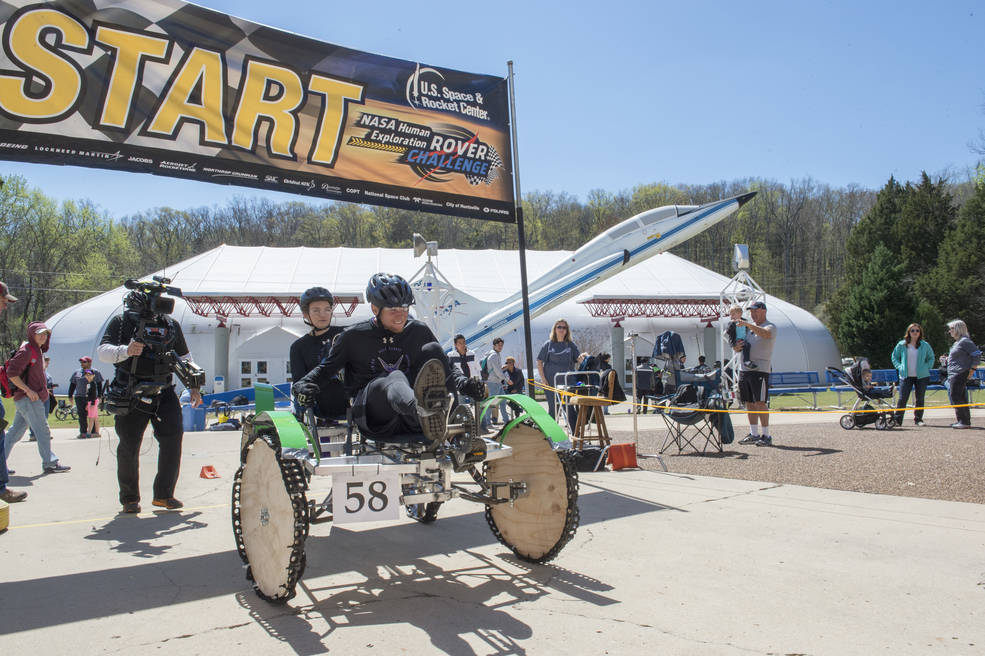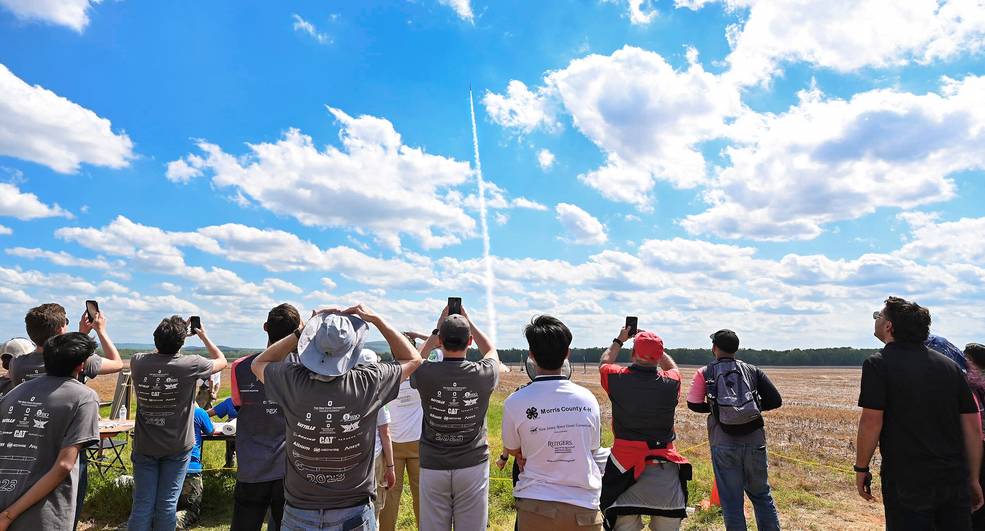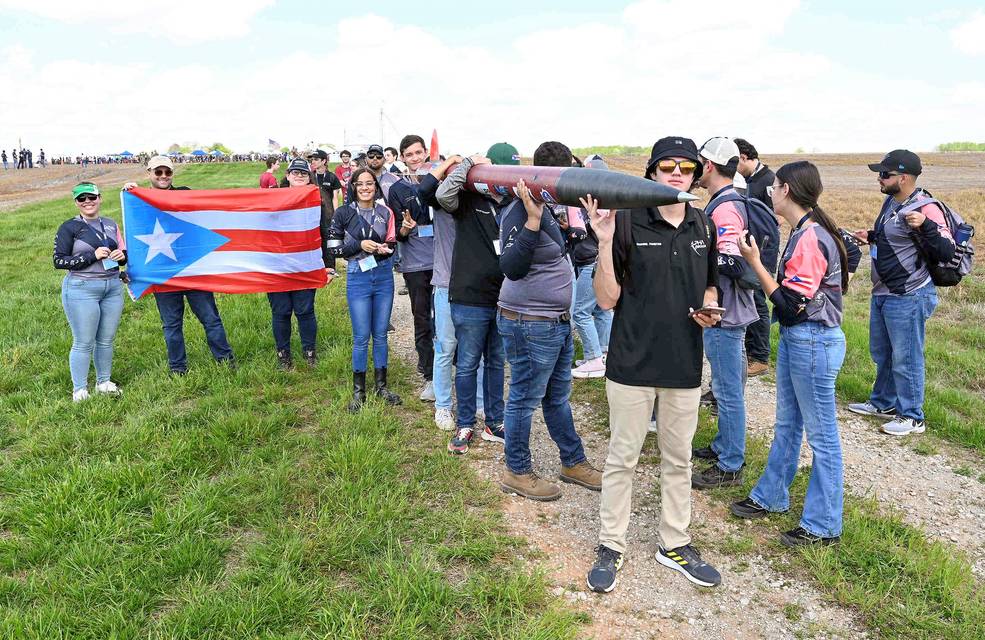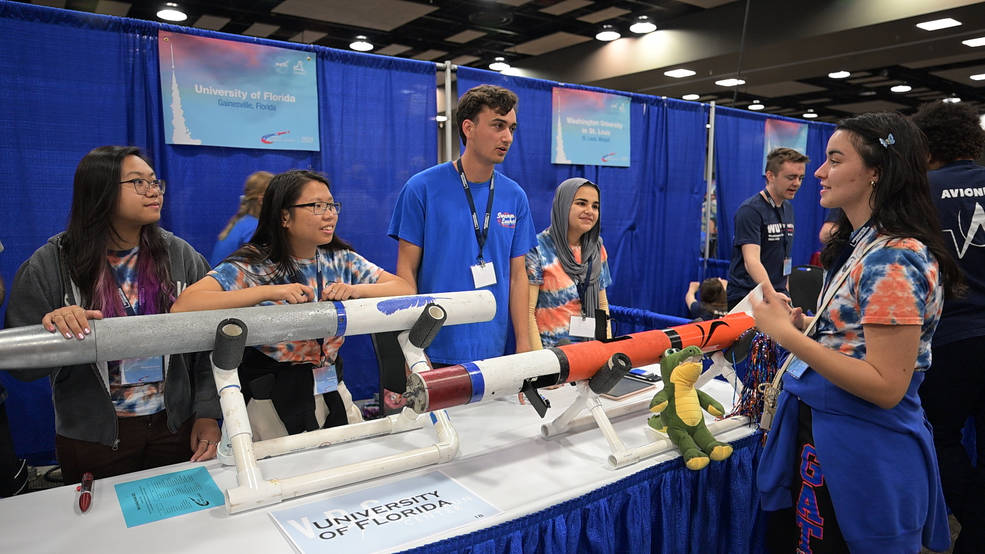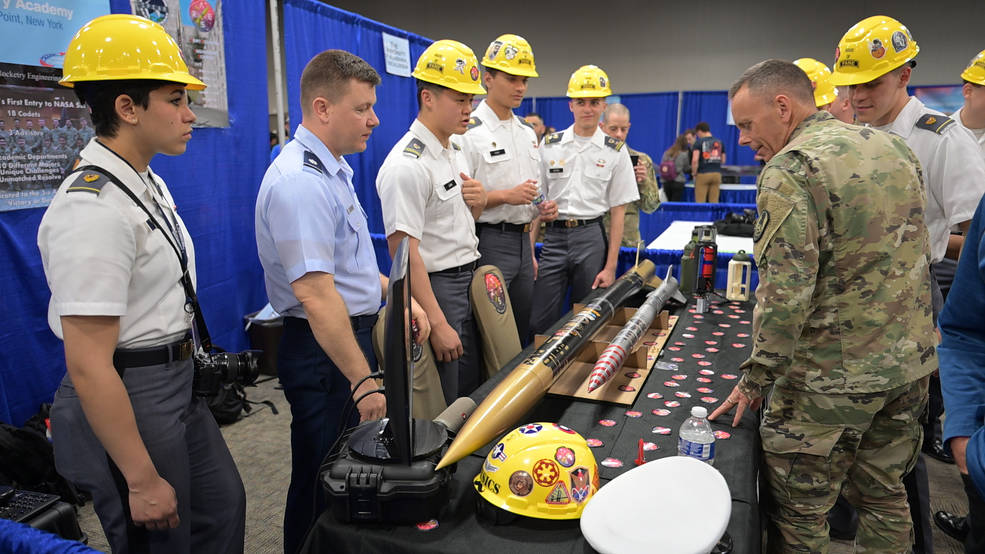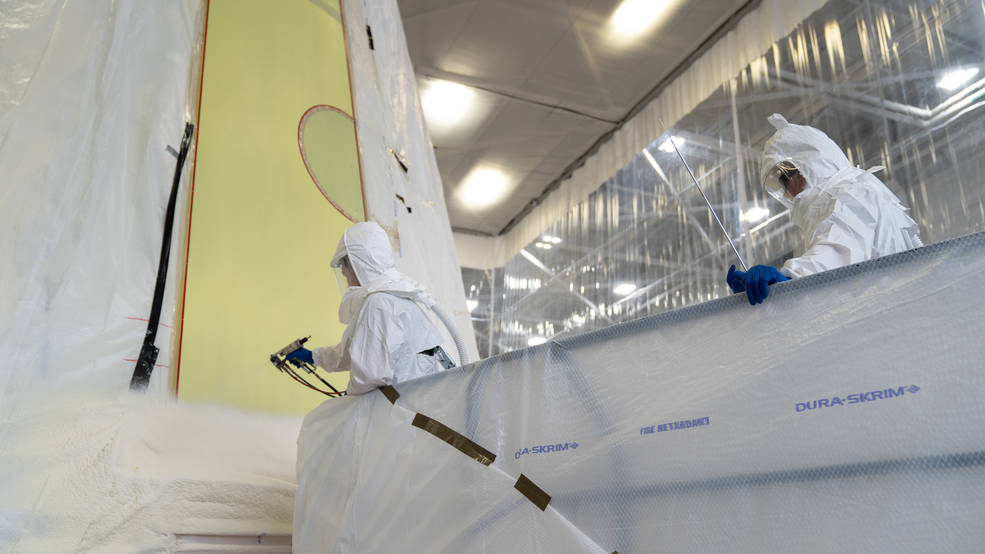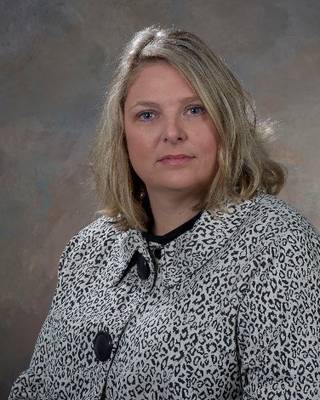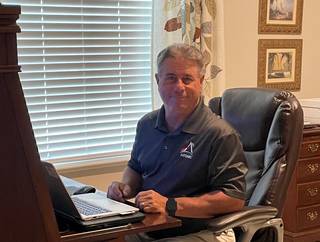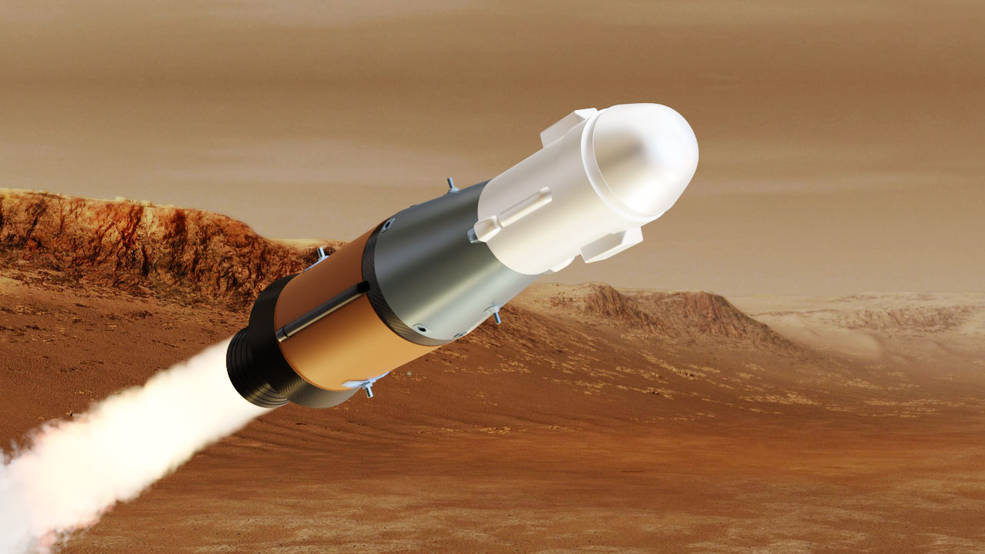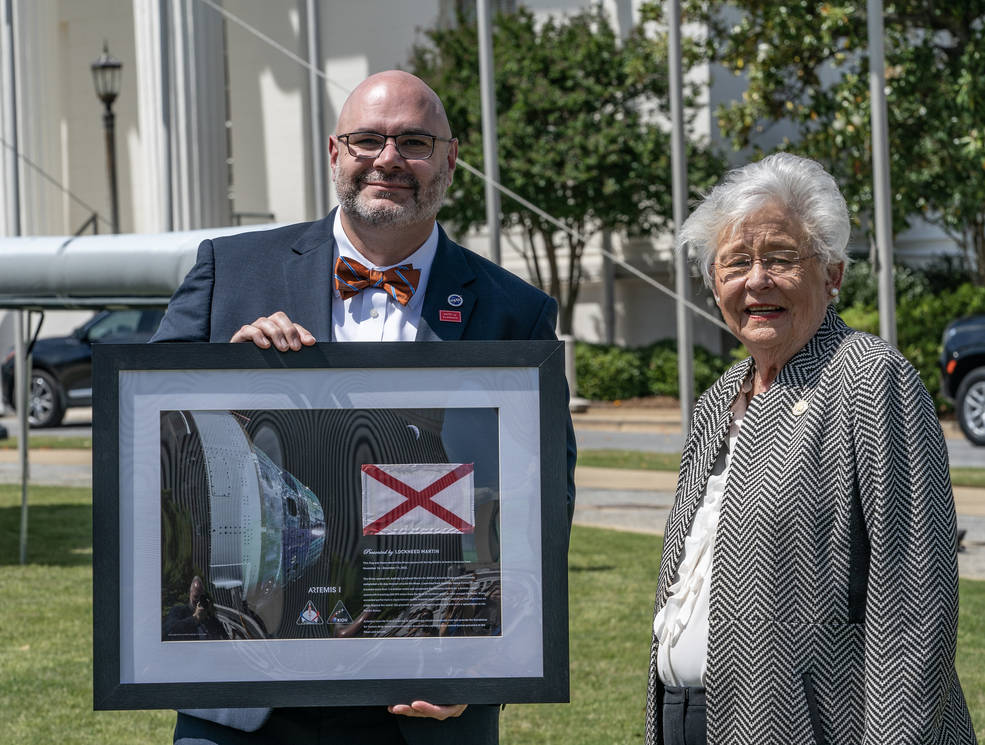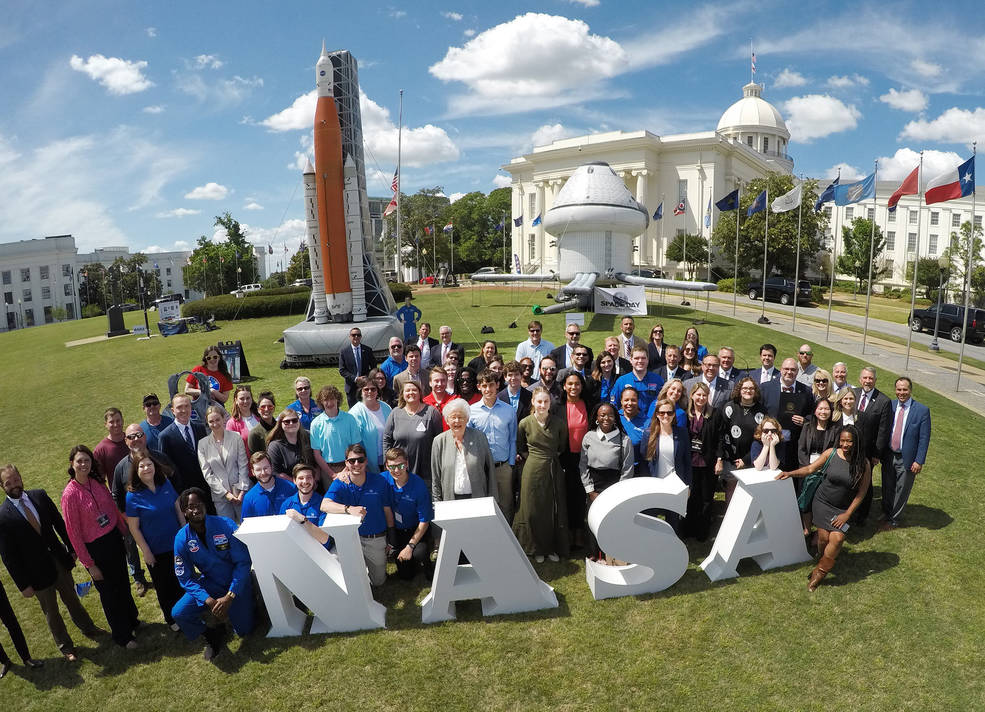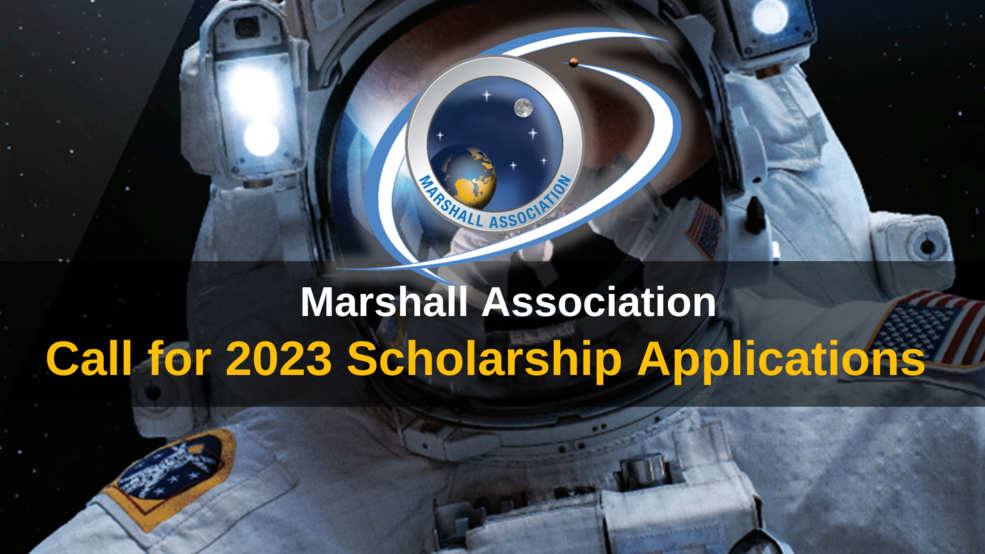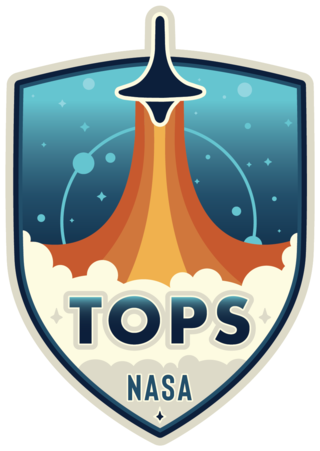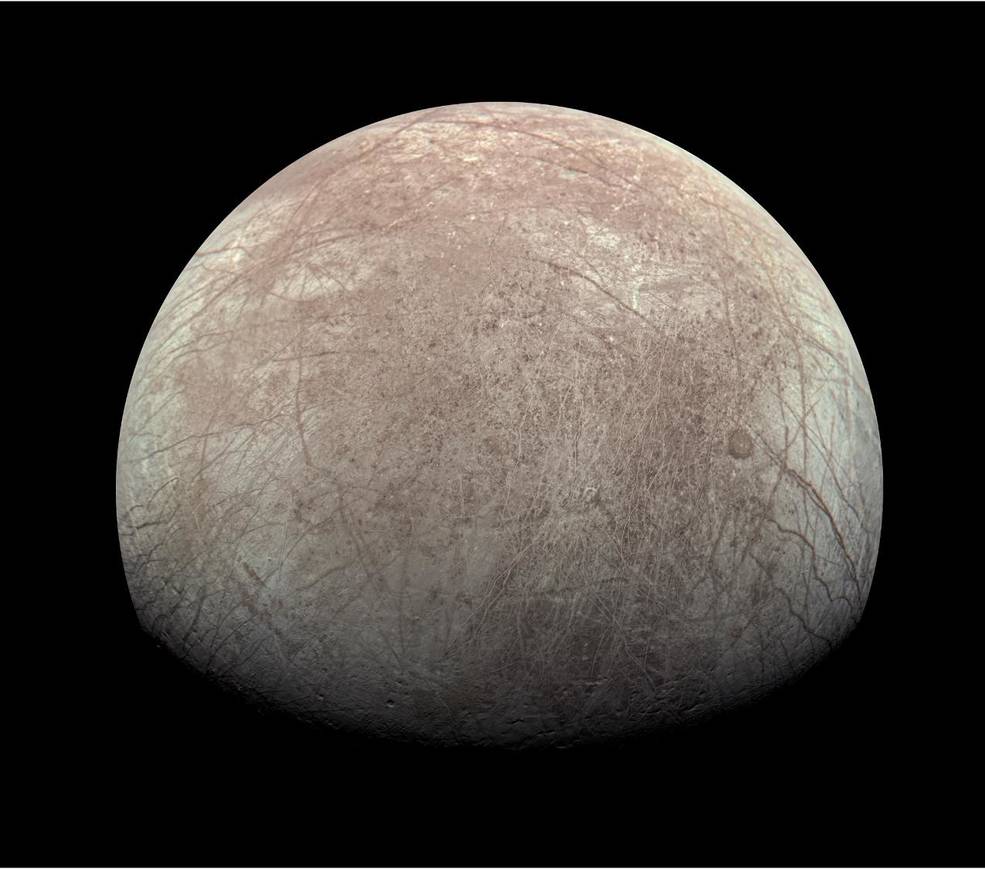The Marshall Star for April 19, 2023.
In This Week’s Star
- NASA Welcomes Return of Human Exploration Rover Challenge
- Rockets Soar During NASA Student Launch Competition
- Technicians Apply Foam to Moon Rocket Hardware for Artemis III
- Jennifer Spurgeon Named Chief S&MA Officer for SLS
- Safety at the Forefront: Robert Vaughan
- Mars Ascent Vehicle Passes Preliminary Design Review
- Marshall Team Members Participate in Alabama Space Day at the Capitol
- NASA Awards Agencywide Digital, Information Technology Contract
- Marshall Association Accepting Scholarship Applications
- NASA Boosts Open Science through Innovative Training
- Lucy Mission Snaps its First Views of Trojan Asteroid Targets
- Icy Moonquakes: Surface Shaking Could Trigger Landslides
NASA Welcomes Return of Human Exploration Rover Challenge
For the first time since 2019, NASA’s Human Exploration Rover Challenge (HERC) returns to in-person competition April 21-22 at the Aviation Challenge camp of the U.S. Space & Rocket Center, near NASA’s Marshall Space Flight Center.
Media, the public, and families are invited to attend this free event from 7:30 a.m. to 3 p.m. CDT both days, or until the last rover completes the course.
More than 500 students from around the world will attempt to drive human-powered rovers across a half-mile-long obstacle course designed to simulate the geographical terrain of the Moon, Mars, and other distant bodies.
HERC will host 48 teams from 16 states, the District of Columbia and Puerto Rico, as well as the countries of Bolivia, Brazil, Colombia, Dominican Republic, India, Mexico, Peru, and Singapore.
To conclude the 2023 season and to recognize all students, NASA will host an in-person awards ceremony April 22, at 5 p.m. in the National Geographic Theater of the Davidson Center for Space Exploration at the USSRC.
The two-day competition and awards ceremony will stream live on NASA’s Marshall YouTube page and NASA’s HERC Facebook page.
Celebrating its 29th year, HERC tasks students from around the world to design, build, and test lightweight, human-powered rovers on a complex obstacle course. In addition, students must also complete mission-focused science tasks, and submit detailed reports capable of passing critical design and safety reviews by NASA engineers.
Marshall hosts HERC with management support provided by NASA’s Office of STEM Engagement – Southeast Region. HERC is one of NASA’s eight Artemis Student Challenges – a variety of activities providing students access to the knowledge and technology required to achieve the goals of the Artemis program. Through Artemis, NASA seeks to land the first woman and first person of color on the Moon, establish long-term lunar science and exploration capabilities, and inspire the next generation of explorers – The Artemis Generation.
Rockets Soar During NASA Student Launch Competition
More than 40 high-powered amateur rockets successfully launched April 15 in North Alabama, each carrying a scientific payload nearly one-mile-high above ground level, as part of a NASA student competition.
“These are sophisticated rockets with advanced payloads, each meeting strict NASA requirements,” said Fred Kepner, NASA’s activity lead for the launch. “Students are demonstrating the crucial skills needed for NASA to continue complex missions of science and discovery.”
The launches were the culminating event of NASA’s Student Launch, a competition tasking students to design, build, and launch rockets in support of NASA research. When students were asked to describe learning from and working with NASA engineers, excited was the word used most often.
“We’re just five kids from New Jersey, we don’t go to the same school or even live in the same city, but here we are launching rockets with NASA,” said Sean McConoughey, of the Morris County 4-H Rocketry Club, from Morristown, New Jersey.
Every fall, NASA accepts proposals from eligible teams across the U.S. and Puerto Rico. If accepted, students then spend the next nine months designing, building, and testing rockets. However, to qualify for the spring launch event, teams must pass critical safety, flight, and launch reviews by NASA.
Student Launch is one of NASA’s eight Artemis Student Challenges – a series of activities providing students access to the Artemis program. Through Artemis, NASA will return humans to the Moon for long-term exploration, including landing the first woman and first person of color on the lunar surface, missions that will help pave the way for future missions to Mars.
“As a young woman, it’s important to be seen leading a team, managing resources, and meeting critical deadlines with NASA, I couldn’t be happier,” said Sindhu Belki, an aerospace engineering major from the University of Alabama. “I’m glad NASA provides this opportunity to be a role model to girls and women interested in space exploration.”
This round of launches took place at Bragg Farms in Toney, minutes north of NASA’s Marshall Space Flight Center. Once all the final flight data has been analyzed, NASA will recognize all students during a virtual awards ceremony at 1 p.m. CDT on June 6.
Marshall hosts the Student Launch challenge with management support provided by NASA’s Office of STEM Engagement – Southeast Region. Funding is provided, in part, by NASA’s Space Operations Mission Directorate and NASA’s Next Gen STEM project. Additional support is provided by Northrup Grumman, National Space Club Huntsville, American Institute of Aeronautics and Astronautics, National Association of Rocketry, Relativity Space, and Bastion Technologies.
Replays of this launch event are available on NASA’s Marshall YouTube page and NASA’s Student Launch Facebook page.
Technicians Apply Foam to Moon Rocket Hardware for Artemis III
Technicians at NASA’s Marshall Space Flight Center apply the first round of spray foam as part of the thermal protection system to the launch vehicle stage adapter (LVSA) of NASA’s SLS (Space Launch System) rocket for Artemis III. The cone-shaped element connects the rocket’s core stage to its upper stage called the interim cryogenic propulsion stage and partially enclosing it. Spray-on foam insulation, along with other traditional insulation materials such as cork, provide thermal protection for every part – no matter how small or large – of the SLS rocket. The insulation is flexible enough to move with the rocket but rigid enough to handle the extreme pressures and temperatures as SLS accelerates from 0 to 17,400 mph and soars to more than 100 miles above Earth in just eight minutes. The thermal protection system for the LVSA is applied entirely by hand using a tool similar to a spray gun. It is the largest piece of SLS hardware to be hand-sprayed. During each session, two technicians take turns applying the foam across the 20 individual “stripes,” or spray lanes, that make up the LVSA. It takes about two weeks to spray all 20 stripes, and technicians will apply another coat of thermal insulation later this summer. The LVSA is fully manufactured at Marshall by NASA and lead contractor Teledyne Brown Engineering. NASA is working to land the first woman and first person of color on the Moon under Artemis. SLS is part of NASA’s backbone for deep space exploration, along with Orion and the Gateway in orbit around the Moon, and commercial human landing systems. SLS is the only rocket that can send Orion, astronauts, and supplies to the Moon in a single mission. Artemis III will land astronauts on the Moon to advance long-term lunar exploration and scientific discovery and inspire the Artemis Generation. (NASA/Brandon Hancock)
Jennifer Spurgeon Named Chief S&MA Officer for SLS
Jennifer Spurgeon has been named to the senior-level position of chief safety and mission assurance officer for SLS (Space Launch System) in the Safety and Mission Assurance Directorate at NASA’s Marshall Space Flight Center.
She will be responsible for directing the safety program and the mission and product assurance activities for the SLS Program, which includes developing and implementing the capability to independently analyze and assess the safety, reliability, maintainability, and quality aspects of the design, development, test, manufacturing, and operational phases for the program.
Spurgeon was previously the program’s deputy chief safety and mission assurance officer for five years, where she assisted in multiple activities, from program management to responsibility for both budget and schedule of the SLS Safety and Mission Assurance Team; and providing input to Safety and Mission Assurance management. She was also a manager to a team responsible for stages safety and mission assurance activities in the SLS Stages Office, including the Remote Management Office at Michoud Assembly Facility.
Spurgeon was safety and mission assurance lead for two Ares I-X elements – avionics and roll control, and supported the Space Shuttle Program after the Columbia accident in development of a reinforced carbon-carbon crack repair material.
She came to Marshall in 2001 as a contractor with Bastion Technologies, supporting the Safety and Mission Assurance Directorate. Previously, she worked in industry as a process and quality engineer.
Spurgeon has a bachelor’s degree in chemical engineering from the University of Alabama in Huntsville. Her awards include a Space Flight Awareness Honoree Award, a Silver Snoopy, an Early Career Achievement Medal, and numerous service and NASA Honor Group awards.
Spurgeon and her husband, George, live in her hometown of Killen, Alabama. They have a son, Lake, and a daughter, Katie Brooke.
Safety at the Forefront: Robert Vaughan
Robert Vaughan was honored with the Golden Eagle Award for his role in helping ensure safe rollback of SLS (Space Launch System) at NASA’s Kennedy Space Center ahead of Hurricane Ian’s landfall in September 2022. The award is presented by Mission Success is in Our Hands, a safety initiative collaboration between NASA’s Marshall Space Flight Center and Jacobs Engineering. Visit here to learn more about the award and how to nominate a team member.
Name: Robert E. Vaughan Jr.
Title: Senior systems engineer – Assembly & Integration, SLS Boosters Element Office
Time in current position: 3 1/2 years
Company: Jacobs Space Exploration Group; based at Kennedy
Years as a NASA contractor: 27
Hometown: Cocoa, Florida
What are your primary responsibilities?
Coordinating with the Boosters Element Office and the on-site Kennedy personnel for the assembly and integration of the SLS solid rocket boosters.
What role does safety play in your job?
An important part of my job includes ensuring the safety of the personnel and the hardware during the assembly and integration of the boosters at Kennedy. I am involved in reviews of the work instructions and multiple discussions regarding the booster assembly and integration work to verify that safe working conditions, operations, and technical requirements are followed.
What do you think is the most interesting aspect of your work?
Being able to work closely with the assembly and integration of SLS flight hardware that will launch humans into space and back to the Moon.
Who inspires you?
My parents, who taught us the value of hard work, getting along with others, and flexibility. Growing up in a military family, we moved around a lot. I think that’s how I learned how to get along with others and quickly develop new relationships.
What is your educational background?
I have a bachelor’s degree in mechanical engineering from the University of Central Florida in Orlando and a master’s degree in technical management from Embry-Riddle Aeronautical University in Daytona Beach, Florida.
Following your time in the Navy, you spent nearly eight years working in business. What led you to leave that line of work and pursue an education and career in engineering?
Most of my years in business were working as a manager, but without a degree. Most of my time in the Navy was spent working as a nuclear machinist’s mate in ships’ engine rooms, which gave me a good technical background. My future father-in-law worked as an engineer at NASA, and he felt that I could get a co-op position in engineering, so I decided to pursue a mechanical engineering degree. By the time I was eligible for a NASA co-op position, the agency had frozen all of its co-op hiring. I kept working on my degree and was fortunate to be hired as a mechanical design engineer at United Space Boosters Inc. on the space shuttle solid rocket booster contract. I couldn’t have asked for a more exciting and rewarding career.
Mars Ascent Vehicle Passes Preliminary Design Review
This illustration shows NASA’s Mars Ascent Vehicle (MAV) in powered flight. NASA continues making progress in its effort to bring the first Mars samples to Earth by successfully completing the MAV preliminary design review. Managed at the agency’s Marshall Space Flight Center, the MAV rocket is part of NASA and the European Space Agency’s ambitious plan to return the Martian rock and dust samples gathered by NASA’s Perseverance to Earth for detailed study. MAV is part of the Mars Sample Return Program managed by the Jet Propulsion Laboratory. The Mars Sample Return campaign would be the first mission to return samples from another planet and would include the first launch from the surface of another planet as well as the first in-orbit rendezvous at another planet. (NASA)
Marshall Team Members Participate in Alabama Space Day at the Capitol
NASA’s Marshall Space Flight Center Deputy Director Joseph Pelfrey presents Gov. Kay Ivey with a flag flown on the Orion spacecraft. Following the presentation on the South Lawn of the Capitol in Montgomery, Gov. Ivey read a proclamation declaring April 11 as Space Day in Alabama. Pelfrey also addressed members of the Alabama Space Authority in the Alabama State House and met with Alabama Secretary of Commerce Greg Canfield and representatives of the Huntsville/Madison County Chamber of Commerce at the Alabama Center for Commerce. (Governor’s Office/Hal Yeager)
Gov. Ivey, at center in front, stands with organizers, exhibitors, and attendees of the 2023 Alabama Space Day event on the South Lawn of the Capitol in Montgomery. Exhibitors and team members from Marshall and industry spoke with students, educators, and members of the public throughout the day. (Credits: Governor’s Office/Hal Yeager)
NASA Awards Agencywide Digital, Information Technology Contract
NASA has selected Rothe Ares Joint Venture of San Antonio to manage digital communication services, as well as information technology services, for all agency centers and headquarters.
Enterprise Multimedia and Integrated Technical Services (eMITS) is a hybrid contract that includes cost-plus-award-fee core services and indefinite-delivery/indefinite quantity task orders. Task orders can be cost-plus or firm-fixed price.
The contract period of performance consists of an initial 90-day phase-in that begins May 2, followed by a 12-month base period, with seven 12-month option periods, as well as a six-month extension, which would extend the full period of performance to Jan. 31, 2032, if all options are exercised.
The potential value of the contract is about $814 million, which includes all options and any IDIQ task order awards.
Work performed under the contract will support NASA’s Office of Chief Information Officer and Office of Communications across all centers and facilities. The contractor will provide related information technology management services; customer collaboration and support services; information management services, and digital communications services including television and multimedia production, social media, and digital exhibits.
Marshall Association Accepting Scholarship Applications
The Marshall Association is accepting applications for 2023 college scholarships through May 8. The association plans to award up to six scholarships to high school seniors or college freshman or sophomores pursuing, or intending to pursue, degrees in undergraduate studies in both technical and non-technical fields. Applicants must be dependents or siblings of current Marshall Association members. The Marshall Association is a professional employee service organization that includes Marshall civil servants, retirees, and contractors. In addition to the scholarship program, the group provides networking and community-building opportunities for members, and monthly speakers. Annual membership is $30, which supports the scholarship program and other events. For more information on the Marshall Association and how to join, visit their page on Inside Marshall. For eligibility details and application materials, visit here or contact Reagan Malone. (NASA)
NASA Boosts Open Science through Innovative Training
NASA is awarding a total of $6.5 million to U.S. institutions for education and training in open science. The promise of open science is that NASA research and data should be more collaborative, accessible, inclusive, and transparent for everyone from the scientist and student to the city manager and citizen.
The agency’s Open-Source Science Initiative (OSSI) is promoting change in the openness and speed of access to scientific information by supporting new training opportunities. To kick off the initiative, NASA is investing in a five-year Transform to Open Science (TOPS) project, which helps researchers engaged with NASA and beyond to put open science into practice.
“NASA is opening up science like never before,” said Chelle Gentemann, program scientist for TOPS. “Opening science calls for a shift in both the culture of science and how we conduct research. These awards equip interested scientists and researchers to become the next leaders and innovators working in the open to transform their fields.”
TOPS projects target scientists and researchers at all career levels – from undergraduate students to principal investigators to program managers. TOPS summer schools and virtual cohorts promote understanding of open science using an introductory curriculum called Open Science 101. A new curriculum called ScienceCore helps learners increase their knowledge and skills in specific disciplines.
“We are building an open science ecosystem for a more equitable, impactful, and efficient scientific future,” said Yaítza Luna-Cruz, program officer for the TOPS Training (TOPST) initiative. “Open science is about making sure that scientific knowledge is not only accessible, but also reproducible and inclusive. TOPS is a crucial step towards increasing participation of historically excluded groups across NASA Science.”
Summer Schools
TOPST summer schools will increase the adoption of open science practices by teaching introductory curriculum and increasing opportunities for collaboration. The selected institutions, their projects, and principal investigators (PIs) are:
- National Louis University, Chicago, IllinoisEnsuring Culturally Responsive Practices and Community Building in Open Science
PI: Robyn Moncrief - Neuromatch Inc., Los Angeles, CaliforniaAn Open, Community Supported, Accessible Summer School for Climate Science
PI: Nicholas Halper - University of Illinois, Urbana-ChampaignBringing Together Open Science and Research Software
PI: Madicken Munk
Virtual Cohorts
Virtual cohorts will offer remote learning and community building around open science principles and practices. The selected institutions, projects, and PIs are:
- Code for Science and Society Inc., Portland, OregonTOPS OpenCore by Embedding Community Values
PI: Yo YehudiCiencia Abierta Accesible: Community-Based Teaching of the TOPS OpenCore Online in Spanish
PI: Laura Acion - Don’t Use This Code, New YorkVirtual Cohorts: Developing Lifelong Committed Interaction with Open Science
PI: Cameron Riddell
ScienceCore
ScienceCore curriculum will complement existing training materials and provide information about open science tools and technology for NASA Earth and space science research. The selected institutions, projects, and PIs are:
- University of Montana, MissoulaSatellite observations and models informing agriculture: Training for open science under climate change
PI: Arthur Endsley - North Carolina State University, RaleighBuilding a framework for ScienceCore Carpentry from a Marine Sciences Lab
PI: Lisa Lowe - NASA’s Goddard Space Flight Center, Greenbelt, MarylandETHOS: ExoplaneTs in the epocH of Open Science
PI: Richard Barry - Million Concepts LLC, Louisville, KentuckyKnowing the Sky: Building Open Science Skills through Native Knowledge Practices
PI: Sierra Brown - University of California, BerkeleyExamining Environmental Justice through Open Source, Cloud-Native Tools
PI: Carl Boettiger - Code for Science and Society Inc., Portland, OregonReproducibly Analyzing Wildfire, Drought, and Flood Risk with NASA Earthdata Cloud
PI: James Munroe - Washington University in St. LouisExoCore: An open science curriculum for enhanced reproducibility and equity in exoplanet research
PI: Tansu Daylan - NASA’s Ames Research Center, Silicon Valley, CaliforniaTraining in Artificial Intelligence and Machine Learning for Space Biological Sciences Using NASA Cloud-Based Data
PI: Lauren Sanders - Columbia University, New YorkScience Core Heuristics for Open Science Outcomes in Learning (SCHOOL)
PI: Kytt MacManus - Polyneme LLC, New YorkHeliophysics ScienceCore curriculum development with emphasis on knowledge representation techniques to increase usability of NASA cloud-based datasets
PI: Donald Winston
As part of the Year of Open Science, NASA is awarding $2.7 million across these different projects this year, with a total of $6.5 million over three years. Read more about the projects.
Lucy Mission Snaps its First Views of Trojan Asteroid Targets
Some of the asteroids NASA’s Lucy mission will visit are still more than 330 million miles away from the spacecraft, which is more than three times the average distance between Earth and the Sun. But despite the great distance and the comparatively small sizes of these asteroids, Lucy caught views of four of them recently.
From March 25 to 27, 2023, Lucy used its highest resolution imager, L’LORRI, to capture its first views of four Jupiter Trojan asteroids. From left to right in the image: Eurybates, Polymele, Leucus, and Orus.
Although the four images are all at the same scale, the orientation of each is different, reflecting the different orientations of the L’LORRI camera as it turned to capture each target.
The targets were also observed for different time periods based on their rotation periods:
- Eurybates images were taken over a span of 6.5 hours.
- Polymele, about 2.5 hours.
- Leucus, 2 hours.
- Orus, 10 hours.
These images are the first in a series of planned observations designed to measure how the Trojan asteroids reflect light at higher angles than is observable from Earth. Though the asteroids are still just single points of light in these images, seen against a background of distant stars, the data will help the team choose exposure times for Lucy’s close-up observations of its targets.
Lucy will fly by these asteroids in 2027 and 2028 as the spacecraft travels through a swarm of small asteroids that lead Jupiter in its orbit around the Sun. Lucy is just more than a year into a 12-year voyage that entails close observation of nine of Jupiter’s Trojans – the first space mission ever to visit them – and two main belt asteroids.
Lucy is a Discovery class mission led by principal investigator Harold “Hal” Levison from the Southwest Research Institute in Boulder, Colorado, who, with a team of scientists and engineers, will address key science questions about the solar system. NASA’s Goddard Space Flight Center will provide overall mission management, systems engineering, and safety and mission assurance. Discovery missions are overseen by the Planetary Missions Program Office at NASA’s Marshall Space Flight Center for NASA’s Planetary Science Division.
Icy Moonquakes: Surface Shaking Could Trigger Landslides
Many of the ice-encrusted moons orbiting the giant planets in the far reaches of our solar system are known to be geologically active. Jupiter and Saturn have such strong gravity that they stretch and pull the bodies orbiting them, causing moonquakes that can crack the moons’ crusts and surfaces. New research shows for the first time how these quakes may trigger landslides that lead to remarkably smooth terrain.
The study, published in Icarus, outlines the link between quakes and landslides, shedding new light on how icy moon surfaces and textures evolve.
On the surfaces of icy moons such as Europa, Ganymede, and Enceladus, it’s common to see steep ridges surrounded by relatively flat, smooth areas. Scientists have theorized that these spots result from liquid that flows out of icy volcanoes. But how that process works when the surface temperatures are so cold and inhospitable to fluids has remained a mystery.
A simple explanation outlined in the study doesn’t involve liquid on the surface. Scientists measured the dimensions of the steep ridges, which are believed to be tectonic fault scarps (like those on Earth) – steep slopes caused when the surface breaks along a fault line and one side drops. By applying the measurements to seismic models, they estimated the power of past moonquakes and found they could be strong enough to lift debris that then falls downhill, where it spreads out, smoothing the landscape.
“We found the surface shaking from moonquakes would be enough to cause surface material to rush downhill in landslides. We’ve estimated the size of moonquakes and how big the landslides could be,” said lead author Mackenzie Mills, a graduate student at the University of Arizona in Tucson, who conducted the work during a series of summer internships at NASA’s Jet Propulsion Laboratory. “This helps us understand how landslides might be shaping moon surfaces over time.”
NASA’s upcoming Europa Clipper mission, bound for Jupiter’s moon Europa in 2024, will give the research a significant boost, providing imagery and other science data. After reaching Jupiter in 2030, the spacecraft will orbit the gas giant and conduct about 50 flybys of Europa. The mission has a sophisticated payload of nine science instruments to determine if Europa, which scientists believe contains a deep internal ocean beneath an outer ice shell, has conditions that could be suitable for life.
“It was surprising to find out more about how powerful moonquakes could be and that it could be simple for them to move debris downslope,” said co-author Robert Pappalardo, project scientist of Europa Clipper at JPL, which manages the mission.
Especially surprising were the modeling results for tectonic activity and quakes on Saturn’s moon Enceladus, a body that has less than 3% of the surface area of Europa and about 1/650 that of Earth. “Because of that moon’s small gravity, quakes on tiny Enceladus could be large enough to fling icy debris right off the surface and into space like a wet dog shaking itself off,” Pappalardo said.
When it comes to Europa, the high-resolution images gathered by Europa Clipper will help scientists determine the power of past moonquakes. Researchers will be able to apply the recent findings to understand whether quakes have moved ice and other surface materials and by how much. Images from the ESA (European Space Agency) Jupiter Icy Moons Explorer (JUICE) mission will offer similar information about Europa’s neighboring Jovian moon, Ganymede.
“We hope to gain a better understanding of the geological processes that have shaped icy moons over time and to what extent their surfaces may still be active today,” Pappalardo said.
Europa Clipper’s main science goal is to determine whether there are places below the surface of Jupiter’s icy moon, Europa, that could support life. The mission’s three main science objectives are to understand the nature of the ice shell and the ocean beneath it, along with their composition and geology. The mission’s detailed exploration of Europa will help scientists better understand the astrobiological potential for habitable worlds beyond our planet.
Managed by Caltech in Pasadena, California, JPL leads the development of the Europa Clipper mission in partnership with the Johns Hopkins Applied Physics Laboratory (APL) in Laurel, Maryland, for NASA’s Science Mission Directorate. APL designed the main spacecraft body in collaboration with JPL and NASA’s Goddard Space Flight Center. The Planetary Missions Program Office at NASA’s Marshall Space Flight Center executes program management of the Europa Clipper mission.
More information about Europa can be found here.


























